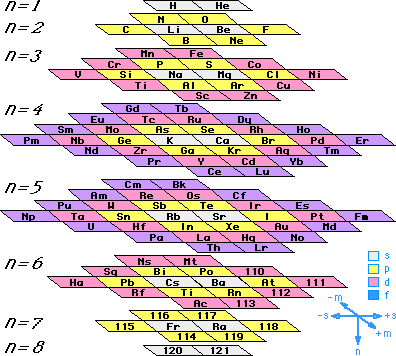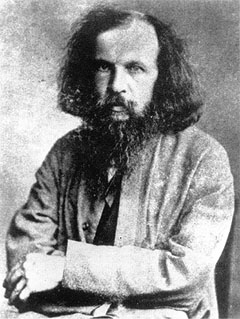The periodic Table of Elements is an amazing chart that helps sad lost souls like you to learn about the elements all around you. The Periodic Table contains approximently 118 elements, but do to the Periodic Table's design, new elements can be added to the list. The table can be broken up into ten different catagorizes that I will get back to later, but first you need a history lesson.

Figure 1: the Periodic Table
Before you learn how to read the Periodic Table, You must learn its history, so lets begin. The first people to organize things into different categorizes based on its attributes were the Greeks. They organized them into four major categories; earth, air, water, and fire. Later on, scientists decided that this system of organization did not work, so scientists decided to try and organize all the matter in the universe on a chart. Many people tried and had many different designs for this element chart. One chart had the elements in zigzag rows, Another one looked like a circle, and one looked like a triangle. Sadly, none of these ideas worked.

Figure two: Dr. Timmothy Stowe's chart
Luckily their was one man how came to help the world with this element organization ordeal. His man was Dmitri Mendeleev, the youngest of seven kids in his family and the man named for the 101 element mendelevium. This Russian scientist is the creator of the modern Periodic Table over 140 years ago. His chart is still used, because his chart was created in such a way that new elements can be easily added to the list.

Figure three: Dmitri Mendeleev
Now that you know how the Periodic Table's history, lets talk about how to read it. The table is a chart made up of small squares. These squares represent an element. The number at the top of the square is the atomic number. This number tells how many protons that an element has. The second number is the atomic symbol. The number on the bottom is the atomic mass.
The squares on the table are then organized into different parts of the table. The first thing is the elements are organized by weight, this means that lighter atoms are put a the top of the list and the heavier atoms are put at the bottom. Then, based on the atoms material composition it is then organized even farther. If the element is a metal, it can be found on the left hand side of the table. If the element is a nonmetal, it can be found on the right hand side of the table. The arrangement of the electrons in the atom's outer shell also helps organize the elements too. I incourage you to learn about periods and groups because its time for me to sign off.
Remember, leave a comment in the comment section down below.

Figure 1: the Periodic Table
Before you learn how to read the Periodic Table, You must learn its history, so lets begin. The first people to organize things into different categorizes based on its attributes were the Greeks. They organized them into four major categories; earth, air, water, and fire. Later on, scientists decided that this system of organization did not work, so scientists decided to try and organize all the matter in the universe on a chart. Many people tried and had many different designs for this element chart. One chart had the elements in zigzag rows, Another one looked like a circle, and one looked like a triangle. Sadly, none of these ideas worked.

Figure two: Dr. Timmothy Stowe's chart
Luckily their was one man how came to help the world with this element organization ordeal. His man was Dmitri Mendeleev, the youngest of seven kids in his family and the man named for the 101 element mendelevium. This Russian scientist is the creator of the modern Periodic Table over 140 years ago. His chart is still used, because his chart was created in such a way that new elements can be easily added to the list.

Figure three: Dmitri Mendeleev
Now that you know how the Periodic Table's history, lets talk about how to read it. The table is a chart made up of small squares. These squares represent an element. The number at the top of the square is the atomic number. This number tells how many protons that an element has. The second number is the atomic symbol. The number on the bottom is the atomic mass.
Figure four: A boron square
The squares on the table are then organized into different parts of the table. The first thing is the elements are organized by weight, this means that lighter atoms are put a the top of the list and the heavier atoms are put at the bottom. Then, based on the atoms material composition it is then organized even farther. If the element is a metal, it can be found on the left hand side of the table. If the element is a nonmetal, it can be found on the right hand side of the table. The arrangement of the electrons in the atom's outer shell also helps organize the elements too. I incourage you to learn about periods and groups because its time for me to sign off.
Remember, leave a comment in the comment section down below.

Great I don't have anything negative! Just line up your pics
ReplyDeleteGreat job! You were able to insert your vitrolic sense of humour into your post this time around. The pictures were good and added to your subject matter. Very few grammitcal and spelling errors; a wonderful blog :D
ReplyDeleteThe blog was great couldn't find anything wrong.
ReplyDeleteGrade-A
Awesome job bro just don't go trolling
ReplyDeleteawesome Nairobi call girls will take care of your needs
ReplyDelete